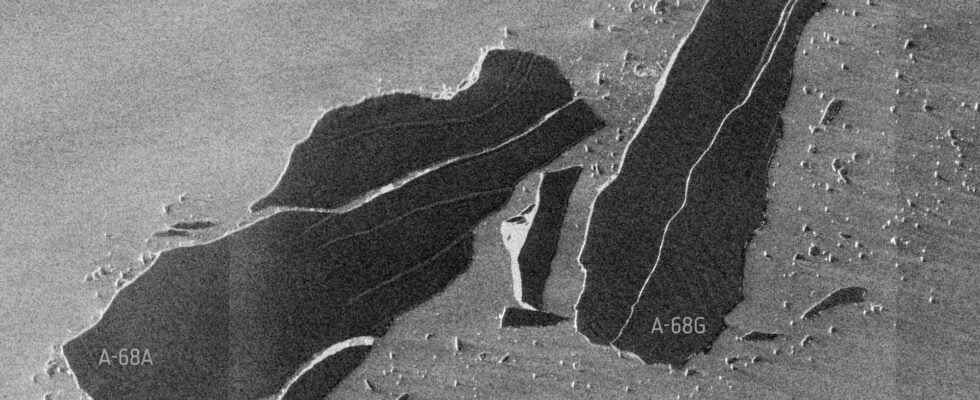One of the largest icebergs on record broke away from Antarctica in 2017. Three and a half years later, it headed perilously towards South Georgia. What threat does this colossal iceberg represent for the ecosystems and seabed of this island?
You will also be interested
[EN VIDÉO] This fault gave birth to a huge iceberg A few days before the calving, on February 26, 2021, of a huge iceberg on the side of the Brunt barrier, in Antarctica, the teams of the British Antarctic Survey (BAS) flew over the zone of the fault called North Rift which is suddenly widened by several hundred meters in just a few hours. The iceberg, larger than the Parisian conurbation, will it take off or will it come crashing down on the platform? Scientists are watching. © British Antarctic Survey
Icebergs are blocks of freshwater ice detached from the front of a glacier and drifting out to sea, melting as they travel. In July 2017, one of the largest icebergs ever recorded, named A-68, broke off from a front of Antarctica and began to drift in the waters of the Southern Ocean. At the time of its creation, the huge iceberg A-68 covered an area of 5800 km2, with a length of 175 km and a width of 50 km. Her keel dipped about 150-180 m under the sea. Shortly after pulling away from Antarctica, the A-68 iceberg lost one piece and redesignated A-68A, and the detached piece was named A-68B. In April 2020, A-68A lost a piece again, later called A-68C.
The disturbing journey of A-68A
The A-68A iceberg remained for its first two years off Antarctica in the cold waters of the weddell sea slowly drifting north. Subsequently, A-68A was caught in a strong ocean current that propelled it through the Atlantic Ocean towards the Drake Passage. As it moved away from the cold waters of Antarctica, the iceberg moved closer to warmer waters and began to melt. The further north the A-68A iceberg drifted, the higher the rate of melting increased leading to a total thinning of 67 meters over its 235 meters of total thickness.
After three and a half years, the A-68A iceberg has headed ominously towards South Georgia, an island in the United Kingdom in the southern Atlantic Ocean. The possibility that the iceberg coming to aground in the shallow waters of South Georgia alarmed scientists enormously. The latter fearing a degradation of the seabed and the ecosystems therein. Furthermore, the iceberg would also have prevented island fauna, such as elephant seals, from going to sea to feed, and could also have blocked deep ocean currents and feeding routes for predators.
Techniques to follow the journey of A-68A
To follow the evolution of the area and the height of the ice of the iceberg A-68A, its path was mapped thanks to observations of five satellite missions different. Data from three of them have made it possible to follow the evolution of its surface: the Sentinel-1 radar mission, which provides all-weather imagery with resolution high spatial, and Modis and Sentinel-3 optical images which have high temporal resolution but cannot be used during cloudy days and polar night.
Data from two other missions were used to measure changes in the height of the ice above the sea surface: the mission CryoSat of the’ESA and the American ICESat-2 mission. Their data was used to calculate the thickness of the iceberg.
A-68A: positive or negative impact?
All of this data combined showed that the A-68A shrank in thickness during its journey to South Georgia, preventing its keel from getting stuck in the seabed. However, these data also made it possible to calculate the amount ofpure water released as the iceberg melted. This fresh water released into the salt waters of the oceans near the island is estimated at 152 billion tons. This amount of fresh water added is significant and could disturb the marine habitat around the island in several ways. The release of fresh water from the icebergs is accompanied by a release of nutrients which promotes organic production, but which also influences the ocean circulation. The waters off South Georgia then remain under observation to find out if this discharge of fresh water will have any positive or negative consequences.
Interested in what you just read?
